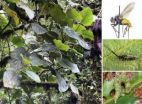(Press-News.org) (Santa Barbara, Calif.) — As the Endangered Species Act (ESA) celebrated its 40th anniversary at the end of 2013, its administrative agency, the U.S. Fish and Wildlife Service (USFWS), was mired in controversy. At issue was a proposal to remove the gray wolf (Canis lupus) from the List of Endangered and Threatened Wildlife and add the Mexican gray wolf (Canis lupus baileyi).
As a result, the USFWS sought an independent peer review of the science behind the proposed rule to delist the gray wolf species. The agency commissioned UC Santa Barbara's National Center for Ecological Analysis and Synthesis (NCEAS) to conduct an unbiased assessment and clarify critical scientific issues.
NCEAS managed and hosted the peer review process, including vetting prospective reviewers, before selecting the final panelists. The USFWS was not involved in the selection of panelists nor was it actively involved in the peer review process.
The panelists unanimously decided that the USFWS's earlier decisions were not well supported by the available science. They acknowledged that last year's proposed rule represented a significant technical effort and recognized its logical consistency with the science used as the primary basis for the USFWS recommendations.
At the same time, the panel highlighted that the proposed rule was strongly dependent on a single publication, which was found to be preliminary and not widely accepted by the scientific community. The panelists identified additional scientific research that should be considered before proposing a change in the listing status of the gray wolf.
"An important part of NCEAS's mission is supporting and advancing science relevant to decision-makers and on-the-ground conservation," said Frank Davis, director of NCEAS. "We are glad that the USFWS sought our help, and we hope that the review process will help all parties moving forward."
Steven Courtney, an NCEAS associate who has worked on ESA issues for many years, chaired the peer review panel. Four additional panelists were chosen for their expertise in such related areas as population dynamics, DNA profiling and knowledge of wolves and other at-risk species.
The final report from NCEAS draws upon the cumulative knowledge of these eminent scientists. The review panel focused solely on scientific issues, not on specific policy recommendations, and its findings were carefully crafted to be completely independent of the government following earlier perceptions of bias in reviewer selection. The full report is posted on the USFWS's Gray Wolf Recovery website and the public comment period has been reopened.
"NCEAS helped us by conducting a transparent, science-based, fair, and well-documented peer review process," said Gary Frazer, the service's assistant director for ecological services. "We wish to thank NCEAS for its support."
INFORMATION: END
Panel issues report on gray wolf science
2014-02-07
ELSE PRESS RELEASES FROM THIS DATE:
Study shows drop in crime rates are less where Wal-Mart builds
2014-02-07
Communities across the United States experienced an unprecedented decline in crime in the 1990s. But for counties where Wal-Mart built stores, the decline wasn't nearly as dramatic.
"The crime decline was stunted in counties where Wal-Mart expanded in the 1990s," says Scott Wolfe, assistant professor of criminology and criminal justice at the University of South Carolina and lead author of a new study. "If the corporation built a new store, there were 17 additional property crimes and 2 additional violent crimes for every 10,000 persons in a county."
The study, titled ...
Researchers at UGent and VIB, discovered potential novel treatment against septic shock
2014-02-07
Septic shock is caused by excessive and systemic reaction of the entire body against infectious agents, in most cases of bacterial origin. The number of deaths by septic shock in intensive care units is very high and is still increasing, despite numerous large scale clinical trials. Scientists of VIB and UGent, supervised by Peter Vandenabeele, demonstrated in a mouse study that a potential novel treatment for sepsis may consist of the simultaneous neutralization of two harmful cytokines in the blood circulation, namely interleukin-1 and interleukin-18.
In the VIB research ...
Dating is refined for the Atapuerca site where Homo antecessor appeared
2014-02-07
One of the issues of the Atapuerca sites that generates the most scientific debate is the dating of the strata where the fossils are found. Therefore, researchers at the Spanish National Research Centre for Human Evolution, among others, strive to settle the dates. A study published by the 'Journal of Archaeological Science' has clarified that the sediment of Gran Dolina, where the first remains of Homo antecessor were discovered in 1994, is 900,000 years old.
The findings at the Lower Palaeolithic cave site of Gran Dolina, in the Sierra de Atapuerca mountain range (Burgos), ...
Protein structure: Peering into the transit pore
2014-02-07
The lipid-rich membranes of cells are largely impermeable to proteins, but evolution has provided a way through – in the form of transmembrane tunnels. A new study shows in unmatched detail what happens as proteins pass through such a pore.
Every cell is surrounded by a surface membrane and contains internal compartments bounded by membranes. Almost one-third of all proteins synthesized in cells must pass through these membranes or be incorporated into them in order to fulfil their functions. However, the fat-rich nature of membranes makes it impossible for most proteins ...
Beta blockers and perioperative care: EHJ editorial addresses controversy
2014-02-07
Zurich, 7 February 2014. Since the end of 2011 when the scientific work of Professor Don Poldermans was first scrutinized there has been controversy in the medical world about the use of beta blockers in perioperative care.
The recent publication - and retraction for proper peer reviewing and revision - in the European Heart Journal (EHJ) of a paper by Professors Cole and Francis from Imperial College, questioning whether beta blockers in perioperative care could lead to a mortality increase brought the topic back into the public eye.
The EHJ has published an editorial ...
The biomass of ocean mesopelagic fish is 10 times higher than estimated
2014-02-07
The total stock of fish on the planet had been reckoned until today to be around 2,000 million tonnes. About half of them were thought to be mesopelagic fish, in other words, ones found at depths of between 200 and 1,000 metres in ocean areas.
However, an international team*, in which AZTI-Tecnalia researchers are participating and which is being led by the doctor in oceanography Xabier Irigoien, has discovered that its abundance could be at least 10 times higher than the original estimate. The results have been published in the journal Nature Communications.
Mesopelagic ...
New plant species a microcosm of biodiversity
2014-02-07
Biologists working in the Andes mountains of Ecuador have described a new plant species, a wild relative of black pepper, that is in itself a mini biodiversity hotspot. The new species, Piper kelleyi, is the sole home of an estimated 40-50 insect species, most of which are entirely dependent on this plant species for survival. This discovery is part of a larger project which focuses on the influence of plant-produced chemical compounds on biodiversity. The study was published in the open access journal PhytoKeys.
The chemical compounds produced by plants are source of ...
Avian flu variant stalks Egypt
2014-02-07
Since its first identification in Asia, highly pathogenic avian influenza—H5N1—has caused significant alarm in the scientific community. While the virus' primary target is birds—tens of millions have already died from it—it is capable of infecting mammals, including humans, causing serious illness and a frightening rate of mortality.
In a new study, Matthew Scotch, a researcher at Arizona State University's Biodesign Institute, tracks the spread of an H5N1 variant in Egypt—a country recently identified as a major epicenter for the virus. In results recently appearing ...
Substance in photosynthesis was at work in ancient, methane-producing microbes
2014-02-07
An international team of researchers led by scientists at Virginia Tech and the University of California, Berkeley has discovered that a process that turns on photosynthesis in plants likely developed on Earth in ancient microbes 2.5 billion years ago, long before oxygen became available.
The research offers new perspective on evolutionary biology, microbiology, and the production of natural gas, and may shed light on climate change, agriculture, and human health.
"By looking at this one mechanism that was not previously studied, we will be able to develop new basic ...
Finding could explain age-related decline in motor function
2014-02-07
SAN ANTONIO (Feb. 6, 2014) — Scientists from the School of Medicine at The University of Texas Health Science Center at San Antonio have found a clue as to why muscles weaken with age. In a study published Feb. 5 in The Journal of Neuroscience, they report the first evidence that "set points" in the nervous system are not inalterably determined during development but instead can be reset with age. They observed a change in set point that resulted in significantly diminished motor function in aging fruit flies.
"The body has a set point for temperature (98.6 degrees), ...





